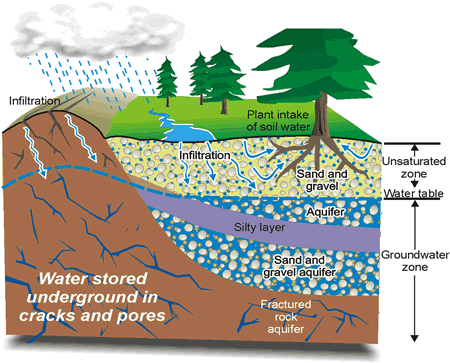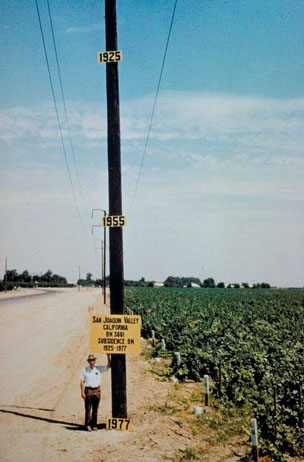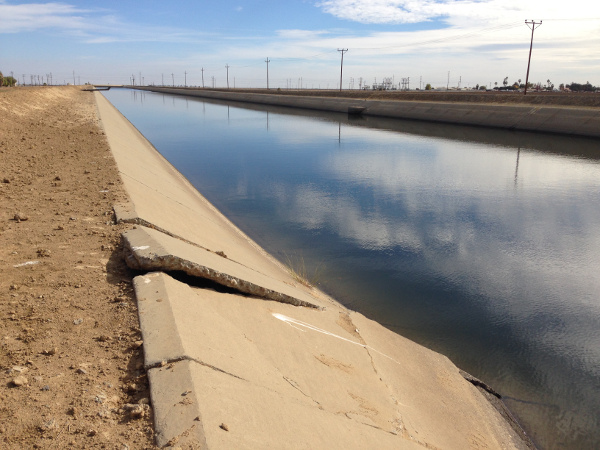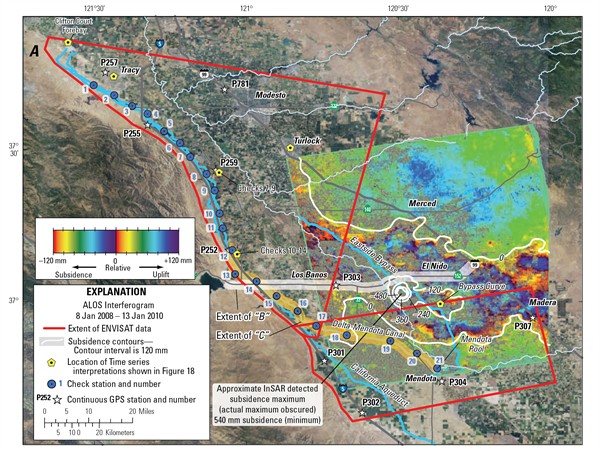California’s Central Valley is divided into two parts: the Sacramento Valley to the north of Sacramento (duh), and the San Joaquin Valley south from Sacramento to the Coastal and Transverse ranges. The San Joaquin Valley is commercial agriculture at its…well, I’m not sure of the word. Finest? Peak? Acme? Densest? Most productive? Scariest? Any of these words would do. Suffice it to say that the San Joaquin is either the top producer of produce in the country, or one of the top producers.
The California drought has severely harmed the farmers throughout the valley. In the July 26, 2014 edition of the Los Angeles Times, the paper reported how wells are being drilled at an ever-increasing rate, and much deeper than before, to try to reach usable water. The stories the farmers tell are heart-breaking and even tragic. Here’s the link:
http://www.latimes.com/business/la-fi-drought-drilling-20140726-story.html
As the drought developed, local counties issued more and more drilling permits. Here’s a graph of the past three years of wells permitted. As the Times story indicates, though, these are simply permits; there aren’t enough drillers to drill all the wells, and many are booked solid for the next 12 months or beyond.
On one level, one can hardly blame the farmers for acting in their own interests. They have no water, and their crops are withering in the middle of one of the worst droughts in the very-limited memory that Californians have about their land. The federal Central Water Project gave them only 20% of what they usually get last year, and nothing this year. The California Water Project run by the state since the early 1960’s was unable to divert any water to the farmers this year, the first time that’s ever happened. There’s no water anywhere in the state, and despite increasing sea-surface temperatures in the eastern Pacific off Perú, which often foretells an El Niño event with increased rain and snow for California, it doesn’t always work out that way. Facing ruin, the farmers do what only makes economic sense: drill deeper for water.
And yet this is very bad news for California. Let’s look at the geology of groundwater to see why the situation is so dangerous. The idea of the water table—that place that you dig to where you will find your hole filling with water—depends on what kind of soil you have. Loosely packed soil, sand, gravel, clastic particles: all these have spaces in between the particles where water can be stored. Drill down to that level, and you have groundwater, used for thousands of years by people all over the world.
As the diagram shows, you can even get water in between cracks in solid rock.
But what happens when you start removing more water than you can replace? The first thing that happens is that you start lowering the water table around you. If you have a really big well, you may lower the water table so much that your neighbors’ wells will go dry because they no longer can reach to the lower table that your drilling has created:
This is a serious problem, exacerbated by the fact that California has no regulatory scheme to monitor and control overpumping, even though this is a classic case of market failure that even the most die-hard of libertarian economists would admit calls for some sort of intervention into the market. You read that right: California does not regulate the removal of groundwater. Even Texas and Kansas do, but not California. We don’t even know how much water is being taken out, because no one is monitoring the usage, which might seem to be useful information to have, possibly?
Good luck at having that happen anytime soon in California. The farmers will scream about their property rights and they will suck every drop of usable water out of the aquifer until the area turns back into a desert. We may get lucky and get several wet years, but the long-term history of California is filled with examples of droughts that lasted for decades.
With no intervention in the market, you can assume things will start to get really nasty pretty soon in the Valley. Those who have the deeper wells will surely be recognized as culprits for wells that dry out. With no governmental intervention, one would hardly be surprised to see open warfare and sabotage start to break out in driest areas of the San Joaquin Valley.
But turning the San Joaquin valley into a wasteland–think of Owens Lake in the Owens Valley in the eastern Sierras, which now has the worst particulate air pollution in the state when the wind blows the dried salts and sediment off the lake bed–is only one aspect of the problem. The San Joaquin farmers have already pushed the local water tables to the breaking point. When you pump water out of the ground, what happens to the space the water used to occupy? The grains of rock are no longer supported by the water, and so the collapse and compact. The ground literally collapsed under you. Geologists call that subsidence:
There’s a famous picture that shows the amount of subsidence in the western side of the San Joaquin Valley, comparing the height of the land since 1923:
This was taken in 1977, almost 40 years ago, and the problem has only gotten worse since then. You can see the serious depletion of the water tables between the 1920’s and the 1950’s, and yet modern tables recording the drawing down of the groundwater, scary as they are, typically only start in 1960, after serious depletion had already occurred. Take a long look at the above picture, and then look at the losses since 1960 and the failure to recharge the basins:
This is seriously bad. Really bad, and it’s not getting better. If the pumping continues without stopping and without a real break in the drought so the aquifers can get partially recharged, much of the San Joaquin Valley will turn into land unusable for agriculture as the water gives out, just like ancient Mesopotamia did when the droughts hit that part of the world. It happens in the Sahel in Africa, and it can happen here. All we need to do to insure that that happens is to sit back and do nothing, as we’ve done for the last centuries. After most of the water is gone and there’s nothing to irrigate the crops, we wait for several centuries, and who knows? Maybe the weather will get wet again and the land will recover and become productive for whomever has survived the drought.
Or maybe not. One of the problems of subsidence flows naturally from this: the soil grains are packed more tightly. Suppose you import water or it rains or you get a flooding river over the land…..where does the water go? If you have subsidence, you by definition have less space to hold the water. So not only are you lacking water to pump out, but you don’t have any (or enough) space to recharge the aquifer even if you can find some water somewhere. The water will stand on the surface or erode the land in runoff, probably causing flooding downstream….well, you begin to get the picture of just how bad this can get. Here’s a link to a US Geological Survey paper on the subject which also covers subsidence after oil and gas removal.
There is an even scarier prospect if pumping gets totally out of control. There are plenty of areas around the Sacramento Delta that are already below sea level. Subsidence is cracking the levees, as this example from the Mendota canal in the Delta (see map at the top of the page) shows:
What happens if so much water is pumped out of the ground that the entire delta is below sea level? We have an example of what can occur: New Orleans in 2005 during Hurricane Katrina. Salt water intrusion is already ruining valuable farmland in the delta; a major flood would be a permanent economic loss of almost incalculable magnitude. Hundred of square miles would be unsuitable for any kind of agriculture, and most likely would be replaced by brackish or salt-water marshes. You could drain them, of course, at great expense, but the salt would already have ruined the topsoil and infiltrated the aquifers. You’re left with an Owens Lake situation described above, a desert in a formerly productive land.
This may or may not happen, but the subsidence rates around Merced are already approaching a foot per year. This will cause widespread damage to anything on the ground, and is intense throughout that area:
What, then, is to be done?
Agriculture takes far more water than the cities do, and the farmers have received subsidized water for so long that they think it’s free. It’s not, and is becoming more and more expensive. Funny how everybody loves “free enterprise” until they have to pay market rates for things. Will food prices go up? Almost certainly, but we probably can’t afford the continued subsidy. There are also lots of low-valued crops, like alfalfa and cotton, that are notorious water hogs that have no right being grown when more cost-effective and profitable crops can be raised with less water on the same land. The prices of agricultural water have been so low that farmers have had no incentive to maintain their irrigation ditches, many of which leak like sieves. In fact, why in an arid climate are we even using irrigation ditches? What about point-source irrigation or drip lines that deliver the water directly to the plants and don’t lose so much due to evaporation and leakage?
This does not mean that the cities do not have a role to play in this as well. I will address future posts to this, but one of the biggest problems is that we have paved over so much urban space that we are not recharging the aquifers under the cities, instead permitting all that fresh water to run off into the ocean. There are many things that can be done to minimize the runoff. Reduced water usage through reduced-flow devices in the home and business would also help, and we may need to give up the idea of lush, verdant suburban lawns extending as far as the eye can see.
We’ve overpumped and overpromised water for more than a century, and haven’t gotten caught–yet. You can live beyond your means for a while, but it will catch up with you sooner or later. Look at the table: after each drought, we draw down more and more, and get to ever lower water levels. How many more times can we keep draining the aquifers until we hit bottom and there’s no more water to be had? The only thing for sure is that we will get there, and that we’re closer than we’ve been before. It’s time for serious thinking on water policy in California.









